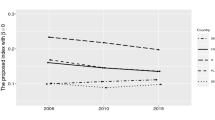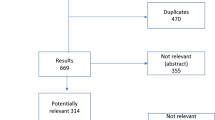Abstract
Universal poverty indexes provide guidelines for how to understand and measure deprivation. However, depending on the dimensions and indicators used, indexes may omit certain forms of deprivation, while highlighting others. Our intention is to carry out a philosophical normative analysis of three of the major multidimensional poverty indexes, assessing the extent to which they are able to portray the deprivation of certain differently-positioned individuals. For this, we look at three cases that we consider relevant for revising universal poverty measures, and introduce the capability approach as the normative framework for our analysis of poverty (understood as capability deprivation). We then assess three multidimensional indexes (Human Poverty Index, Multidimensional Poverty Index and the York model) by how they measure capability deprivation. We consider, finally, that these universal indexes insufficiently portray the breadth of deprivation suffered in these cases, and suggest the inclusion of a relational dimension in poverty measurement as a way to improve this deficit.
Access this chapter
Tax calculation will be finalised at checkout
Purchases are for personal use only
Similar content being viewed by others
Notes
- 1.
By “universal” we mean indexes which intend to be applicable regardless of the individual’s condition (age, gender, location, etc.), thus measuring poverty in total terms.
- 2.
Using a capability approach as the normative foundation for defining and measuring poverty is not novel. Actually, both the HPI and the MPI are explicitly based on Amartya Sen’s approach to human development, and on his revision of income and resource-based metrics of inequality and poverty (Sen 1999, Ch. 4, Alkire et al. 2015, pp. 3–8). We consider it important to highlight this, however, because part of our concern with the multidimensional poverty indexes analysed in the next section lies precisely in their insufficient translation of this basic normative grounding into their actual measurement of poverty.
- 3.
What these basic capabilities are is a matter of on-going debate. While some capability theorists have developed precise lists of the particular capabilities that should be considered as basic (Nussbaum 2011; Robeyns 2003, among many others), Amartya Sen (1999) has preferred to keep the normative framework without a precise list, so that it can adapt to changing circumstances, and so that an appropriate list might be defined via a process of democratic deliberation. Nevertheless, Sen does make use of specific examples throughout his work. Some of his recurrent examples of basic capabilities are: being able to appear in public without shame, being able to take part in the life of the community, being able to avoid hunger, and being able to achieve good health (Sen 2006, p. 35).
- 4.
This is inspired by Sen’s comparative assessment of the quality of life of a fasting Ghandi and a person starving in a famine (Sen 1999, p. 292).
- 5.
OPHI has identified these five “missing dimensions” in poverty indexes, which have been referenced by people living in poverty. For a detailed discussion on each of these dimensions, see Alkire (2007).
- 6.
- 7.
- 8.
At the Children’s Congress on Child Labour, Biggeri and his group of researchers developed a conceptualization of children’s capabilities through the children’s own subjective assessment of what they require.
- 9.
We are especially grateful to Valentin Beck and Robert Lepenies for their thorough and valuable comments and suggestions in our revision of the chapter. Thanks as well to Zlata Bozac, Myles Hourican, Olivier Malay, Sanjay Reddy, Pierre-Etienne Vandamme and Jonathan Wolff for their comments and readings. Earlier versions were presented at the Hoover Chair of Economic and Social Ethics (Louvain-la-Neuve) and at the Dimensions of Poverty conference (Berlin). This was supported by the TADS (Taking Age Disadvantage Seriously) project and partially funded by the Grantová Agentura České Republiky [Grant number 17-266295].
References
Adams-Langley, Stephen. 2013. A Place2Be: A case study of a child with multiple risk factors. International Journal for School-Based Family Counselling 5: 1–14.
Alkire, Sabina, ed. 2007. Special issue: The missing dimensions of poverty data. Oxford Development Studies 35: 347–486.
Alkire, Sabina, and James E. Foster. 2011. Counting and multidimensional poverty measurement. Journal of Public Economics 95: 476–487.
Alkire, Sabina, and José M. Roche. 2011. Beyond headcount: Measures that reflect the breath and components of child poverty. OPHI Working Papers 45, University of Oxford.
Alkire, Sabina, Maria Emma Santos. 2010, July. Multidimensional poverty index. OPHI Research Briefs. Oxford: Oxford University.
Alkire, Sabina, and Andy Sumner. 2013. Multidimensional poverty and the post-2015 MDGs. OPHI Working Paper 61, University of Oxford.
Alkire, Sabina, James E. Foster, Suman Seth, Maria E. Santos, José M. Roche, and Paola Ballon. 2015. Multidimensional poverty measurement and analysis. Oxford: Oxford University Press.
Biggeri, Mario, Renato Libanora, Stefano Mariani, and Leonardo Menchini. 2006. Children conceptualizing their capabilities: Results of a survey conducted during the first Children’s world congress on child labour. Journal of Human Development 7: 59–83.
Bradshaw, Jonathan, and Naomi Finch. 2003. Overlaps in dimensions of poverty. Journal of Social Policy 32: 5113–5525.
Ci, Jiwei. 2010. Agency and other stakes of poverty. In Freedom from poverty as a human right. Volume 2, ed. Thomas Pogge, 111–135. Paris: UNESCO Publishing.
De Neubourg, Chris, Jingqing Chai, Marlous de Milliano, and Ilze Plavgo. 2012. Step-by-step guidelines to the multiple overlapping deprivation analysis (MODA). Innocenti Working Papers 2012–10, UNICEF Office of Research.
Deveaux, Monique. 2015. The global poor as agents of justice. Journal of Moral Philosophy 12: 125–150.
Ferrone, Lucia, and Yekaterina Chzhen. 2016. Child poverty in Armenia: National multiple overlapping deprivation analysis. Innocenti Working Papers 2016–24, UNICEF Office of Research.
Godinot, Xavier, and Robert Walker. this volume. Poverty in all its forms: Determining the dimensions of poverty through merging knowledge. In Dimensions of poverty, ed. Valentin Beck, Henning Hahn, and Robert Lepenies. Berlin/Heidelberg: Springer.
Hick, R., and T. Burchardt. 2017. Capability deprivation. In The Oxford handbook of the social science of poverty, ed. David Brady and Linda M. Burton. Oxford: Oxford Handbooks Online. https://doi.org/10.1093/oxfordhb/9780199914050.013.5.
Ibrahim, Solava, and Sabina Alkire. 2007. Agency and empowerment: A proposal for internationally comparable indicators. Oxford Development Studies 35: 379–403.
International Labour Organization (ILO). 2005. Child labour stories. In InFocus programme on promoting the declaration on fundamental principles and rights at work. http://www.ilo.org/wcmsp5/groups/public/%2D%2D-ed_norm/%2D%2D-declaration/documents/publication/wcms_decl_fs_44_en.pdf. Accessed 20 July 2017.
Krishnaji, N. 1997. Human poverty index: A critique. Economic and Political Weekly 32: 2202–2205.
Lister, Ruth. 2004. Poverty. London: Polity Press.
Narayan, Deepa, Robert Chambers, Meera K. Shah, and Patti Petesch. 2000. Voices of the poor. Crying out for change. Oxford: Oxford University Press.
Narayan, Deepa, Lant Pritchett, and Soumya Kapoor. 2009. Moving out of poverty: Volume 2. Success from the bottom up. Washington, DC: World Bank and Palgrave Macmillan.
Nussbaum, Martha. 2011. Creating capabilities. The human development approach. Cambridge, MA: Harvard University Press.
OPHI. 2015. Measuring multidimensional poverty: Insights from around the world. In Informing policy brochure.http://www.ophi.org.uk/wp-content/uploads/Informing-Policy-brochure-web-file.pdf. Accessed 25 July 2017.
Parr, Tom. 2018. How to identify disadvantage: Taking the envy teste seriously. Political Studies 66: 306–322.
Pogge, Thomas, and Sanjay G. Reddy. 2005. How not to count the poor. https://ssrn.com/abstract=893159. Accessed 5 Nov 2018.
Pogge, Thomas, and Scott Wisor. 2016. Measuring poverty: A proposal. In Oxford handbook of well-being and public policy, ed. Matthew D. Adler and Marc Fleurbaey, 645–676. Oxford: Oxford University Press.
Robeyns, Ingrid. 2003. Sen’s capability approach and gender inequality: Selecting relevant capabilities. Feminist Economics 9: 61–92.
———. 2017. Wellbeing, freedom and social justice. The capability approach re-examined. Cambridge: Open Book Publishers.
Sen, Amartya. 1992. Inequality reexamined. Cambridge, MA: Harvard University Press.
———. 1999. Development as freedom. Oxford: Oxford University Press.
———. 2006. Conceptualizing and measuring poverty. In Poverty and inequality, ed. David B. Grusky and Ravi Kanbur, 30–46. Stanford: Stanford University Press.
———. 2009. The idea of justice. Cambridge, MA: Harvard University Press.
United Nations. 2015. The world’s women 2015: Trends and statistics. New York: United Nations, Department of Economic and Social Affairs, Statistics Division.
Wolff, Jonathan. 2015. Social equality, relative poverty and marginalised groups. In The equal society: Essays on equality in theory and practice, ed. George Hull, 21–41. London: Lexington books.
Wolff, Jonathan, and Avner De-Shalit. 2007. Disadvantage. Oxford: Oxford University Press.
Author information
Authors and Affiliations
Corresponding author
Editor information
Editors and Affiliations
Rights and permissions
Copyright information
© 2020 Springer Nature Switzerland AG
About this chapter
Cite this chapter
Brando, N., Pitasse Fragoso, K. (2020). Capability Deprivation and the Relational Dimension of Poverty: Testing Universal Multidimensional Indexes. In: Beck, V., Hahn, H., Lepenies, R. (eds) Dimensions of Poverty. Philosophy and Poverty, vol 2. Springer, Cham. https://doi.org/10.1007/978-3-030-31711-9_17
Download citation
DOI: https://doi.org/10.1007/978-3-030-31711-9_17
Published:
Publisher Name: Springer, Cham
Print ISBN: 978-3-030-31710-2
Online ISBN: 978-3-030-31711-9
eBook Packages: Religion and PhilosophyPhilosophy and Religion (R0)




